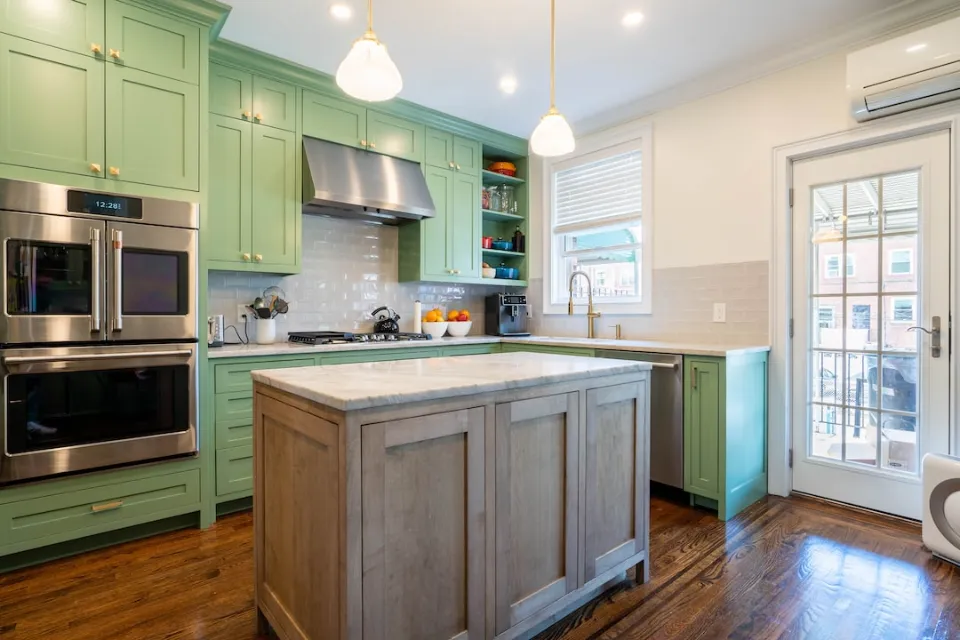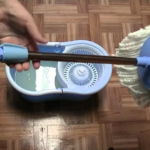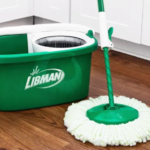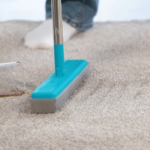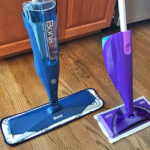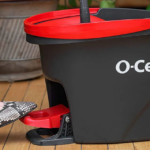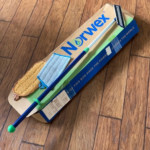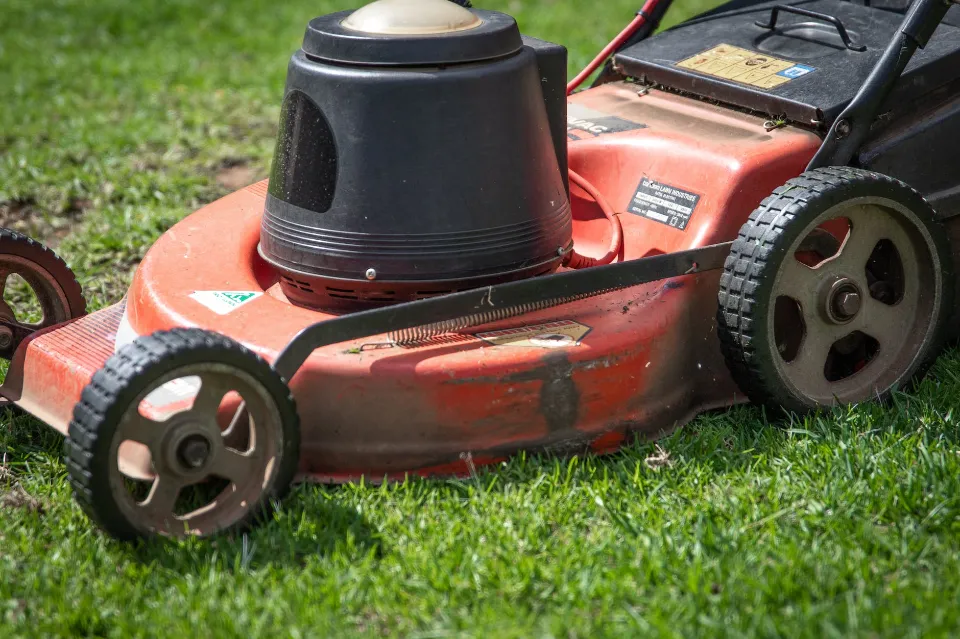Even retailers occasionally use the terms interchangeably when referring to quartz and quartzite, two high-end countertop materials derived from quartz.
Natural, porous stone is cut precisely to size and used to make quartzite countertops. Engineered stone is used to create quartz countertops, which are then shaped to order.
We’ll go over the differences between these two countertop materials in this post, along with some reasons why a quartz countertop or quartzite countertop might be the best option for you.
What is Quartz?
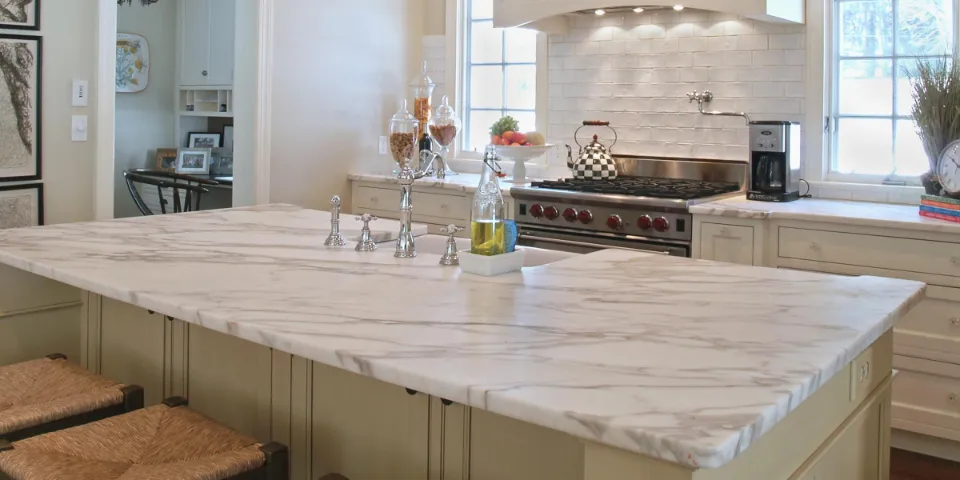
Quartz is a synthetic substance created from resin and mineral chips. These components work together to create a solid surface that can be molded into any shape or size. Quartz is made to resemble natural stone, but because it is manufactured rather than formed underground, its patterns tend to be more uniform. Due to the fact that it can be manufactured in a facility rather than being extracted from the ground, it is also less expensive than natural.
When remodeling a kitchen or bathroom, quartz works well because it is man-made and is available in a wide range of colors and patterns, making it easy to match with the cabinets, flooring, and other features. Quartz is available in a wide range of colors; in fact, it is difficult to find one.
Quartz is produced to have a smooth surface. When you run your hands over a quartz countertop, you’ll feel a cool, smooth surface that is easy to wipe clean after spills. The resins that are used to bind the quartz in the manufacturing process make it easy-to-clean. The resins also render the stone non-porous, preventing it from absorbing liquids that are spilled on it, even if they remain there for a long time.
Because it is attractive, strong, and simple to maintain, quartz is a choice that is becoming more and more common for countertops. It can withstand regular use and doesn’t require frequent sealing. For families with children, whose countertops are sure to sustain damage over time, being low-maintenance makes it particularly appealing.
What is Quartzite?
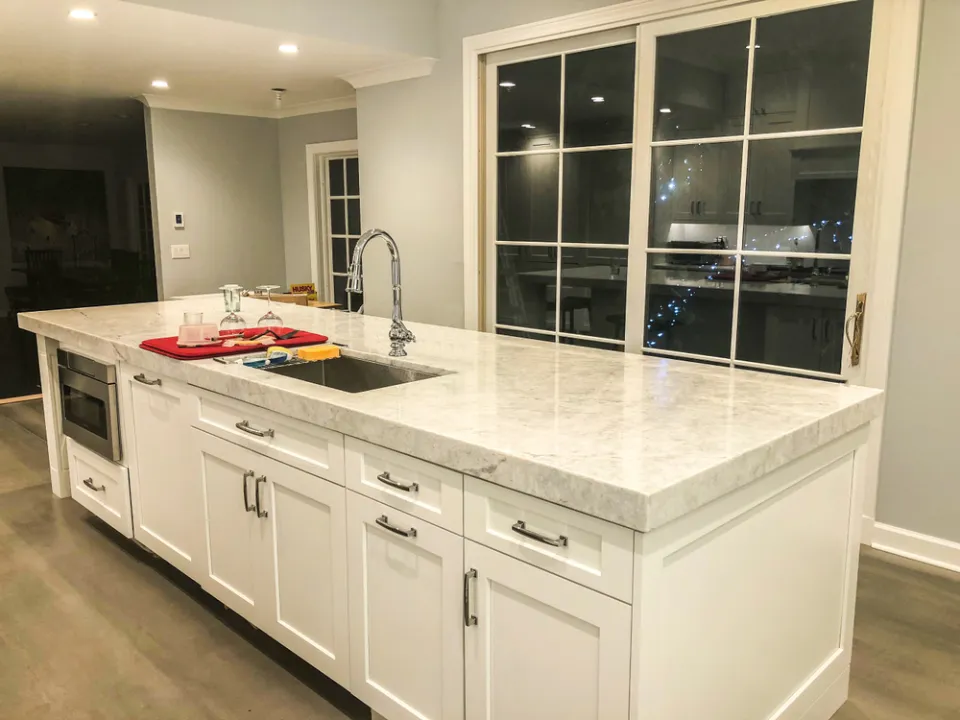
Sandstone changes underground as a result of exposure to high temperatures and pressures, forming quartzite, a naturally occurring stone. Typically, quartzite is mined at a quarry and then cut into slabs for countertops.
The fact that quartzite’s colors and patterns are a direct result of the heat and pressure it undergoes inside the earth is what distinguishes it from other types of rock. They are left in their unaltered natural state. The majority of quartzite is gray or white in color, but it can also occasionally have a red or pink tint. The way the minerals form patterns inside of the slab also varies. From one end of the slab to the other, the patterns might occasionally differ.
Quartzite is a highly regarded and valuable material that is mined using a method akin to that of marble or limestone. People who prefer a more natural, earthy aesthetic for the features in their homes frequently choose it as a popular option. Due to its inherent characteristics, quartzite has a slightly rough texture.
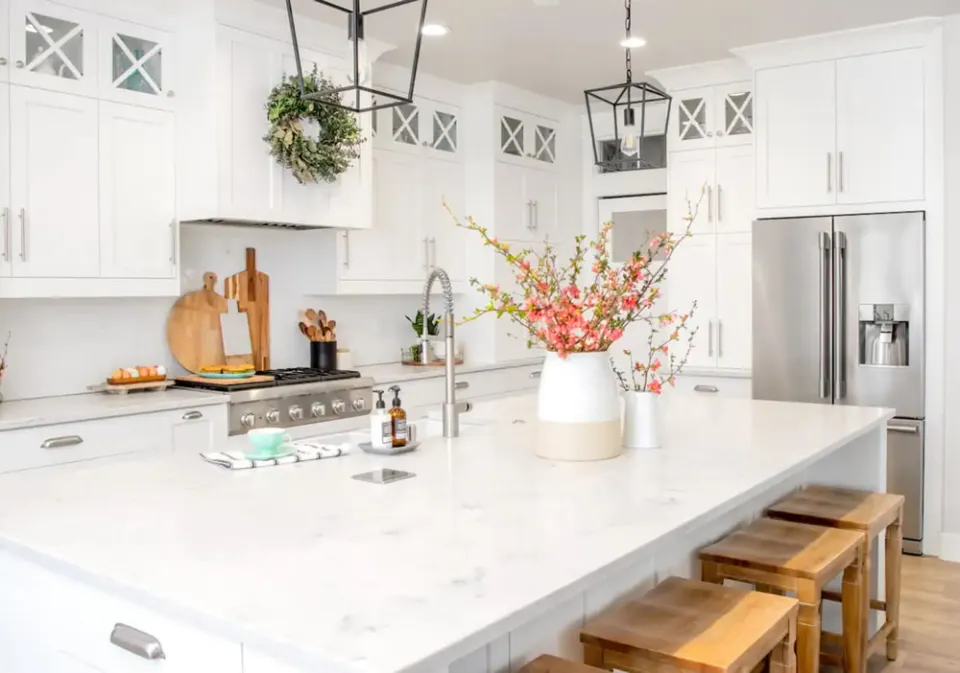
Pros and Cons of Quartz and Quartzite
Between quartz and quartzite, what is the difference?
The two materials, quartz and quartzite, differ in some ways, though neither is superior to the other. Consider their parallels and dissimilarities to assist you in determining which one best suits your requirements.
Pros of Quartz
Quartz is a great material to use in your home for a variety of reasons:
- It repels moisture. Quartz is not porous because of how it is made. If liquid is spilled on it, it won’t absorb it; as a result, stains or an unwelcome bacteria buildup may result. This also means that it can be cleaned with any surface cleaner without risk of damage. If you have children or you tend to make a mess when you cook, this can be an appealing feature.
- It’s low-maintenance. Because quartz is non-porous, it doesn’t need to be resealed every year to protect it from spills and stains — and it won’t etch, which is what happens when certain acidic foods interact with your countertops for an extended time period. There is not much you can do to alter the fact that it is permanently sealed. In addition, it can be cleaned quickly and easily with almost any store-bought cleaner.
- It’s available in a variety of patterns and colors. Quartz can be made in a wide range of hues and patterns thanks to the manufacturing process. That means it’s easier to incorporate into just about any design or color scheme. Quartz countertops give you the flexibility to design around existing cabinetry or a beloved backsplash, rather than having to coordinate everything else with your countertops.
Cons of Quartz
Using quartz in your kitchen could have some disadvantages.
- It’s sensitive to heat. You shouldn’t put hot pans or baking trays directly on top of a quartz countertop because the resins used to make it start to melt at about 300 degrees Fahrenheit, which increases the risk of etching. If you do, they’ll leave a scorch mark or tiny indentation where the resin starts to melt. It can be protected by placing a potholder between the hot dish and the countertop, but it’s important to understand how heat affects quartz.
- It has fewer pattern options. Since quartz is man-made, its patterns are frequently more constant across the entire slab. From beginning to end, it will have a uniform appearance. This might be advantageous if you’re seeking consistency. However, quartz may not meet your design needs if you’re looking for a countertop with a green, natural appearance.
- Mid-sized budgets should use it. Despite being more affordable than quartzite, quartz is still regarded as a luxurious material, and as a result, it frequently costs more than natural stone. When compared to natural stone countertops, quartz countertops are less expensive to maintain over time because they don’t need to be sealed annually. If you want to save money now rather than in the long run, you should still consider quartz over natural stone.
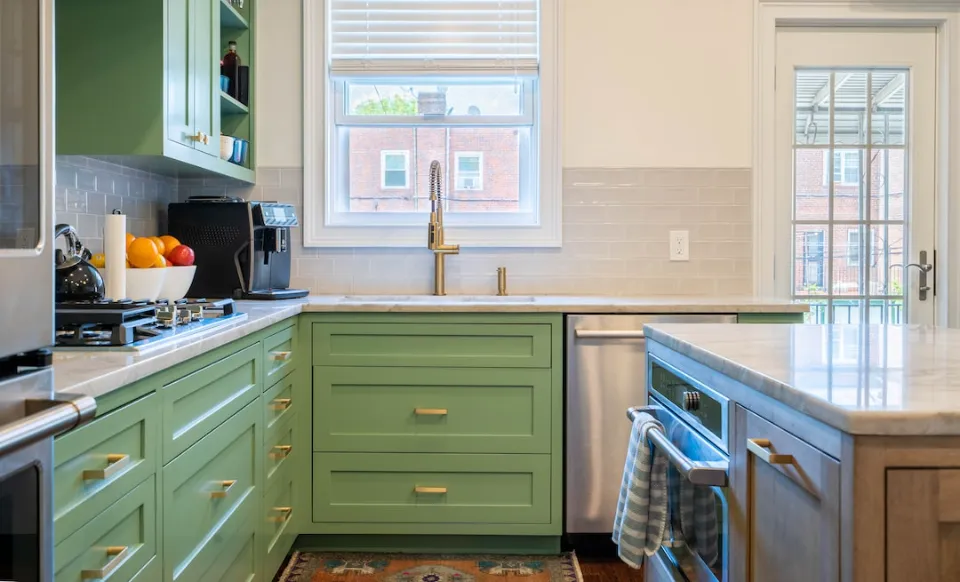
Pros of Quartzite
Concerned with quartzite? Some of its benefits include:
- It’s all-natural. The mineral silica holds the quartz grains in quartzite, which ranges in content from 90 to 99 percent. Quartzite is the epitome of naturalness. This is a great choice if you want to stick with using natural materials throughout your home or if you’re designing a kitchen or bathroom with a natural feel.
- It looks genuine. For some people, manufactured countertops can appear overly polished or a little too uniform. Contrarily, many homeowners prefer the distinctively earthy appearance and feel of quartzite. Besides boasting a natural pattern that varies throughout the slab, it even feels like natural stone.
- It is resistant to acid and scratches. A quartzite surface can withstand light knifework because it is between a 7 and an 8 on the Moh’s Hardness Scale. Even though we never advise substituting quartzite for a cutting board, it’s comforting to know that it won’t easily chip or break if the knife slips out of your hand or if you’re rushing to slice a sandwich and forget to grab a cutting board.
- It’s heat resistant. There’s no need to use potholders with quartzite countertops. Placing hot pans or baking dishes directly on its surface is no problem because it is a strong material that can withstand the heat. For those who frequently cook or struggle to find a potholder when they need one, quartzite’s heat resistance may be appealing.
- It’s durable: Due to its resistance to etching and scratching, quartzite is a fantastic substitute for marble.
You Might Also Like: Alternatives to White Marble Countertops
Cons of Quartzite
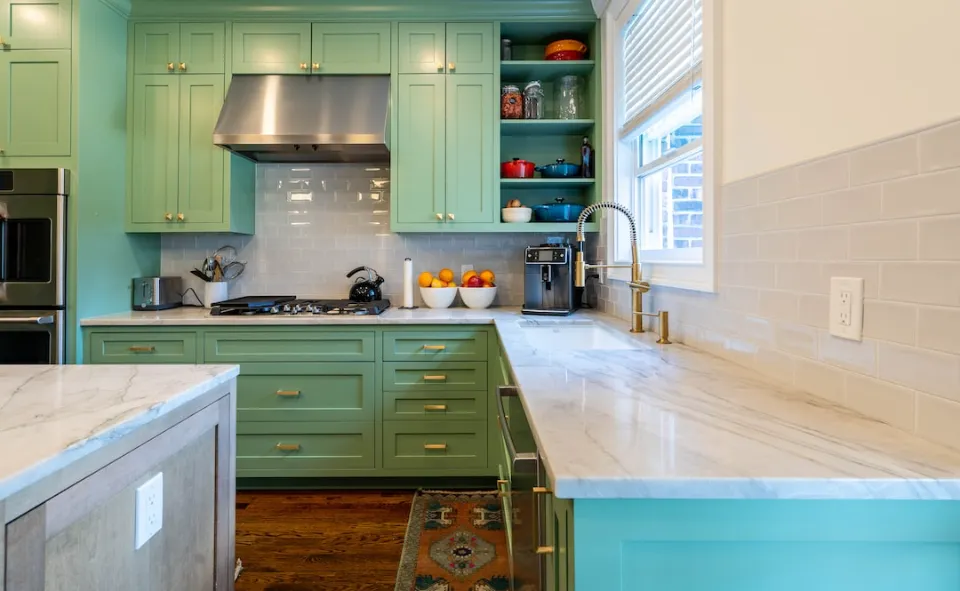
Although quartzite is a great option for kitchen or bathroom countertops, it’s important to understand the challenges you may face if you choose it:
- It has a higher cost. The process to mine and refine quartzite is labor-intensive. After the slab is pulled from the ground, it’s cut to exact size specifications with a diamond blade. This indicates that each countertop is precisely cut and made to order, costing a little bit more than quartz or other man-made materials. The final cost of a countertop is determined by the size of the countertop and the particular material you choose. Certain quartzite options may occasionally be comparable to a higher-end granite.
- It requires annual maintenance. Because quartzite is a porous substance, it must frequently be sealed to keep liquids from soaking into its surface. You must reseal quartzite every year to avoid staining or bacterial growth within the stone’s pores. Quartzite will already be sealed when it is first installed.
- It’s available in a limited range of colors. With the exception of the occasional pink or red hue, quartzite is typically found in various shades of white and gray. If you are attempting to match it to preexisting cabinets or a predetermined color scheme, the limited color palette can be frustrating. The stone’s variation in patterns also means that its color tones can differ from one end of the stone to the other, which can turn off people who are determined to have a kitchen or bathroom with a totally uniform appearance.
What Projects Are Best for Quartz and Quartzite?
The cool thing about quartz and quartzite is that they have other uses, despite the fact that we have used the example of kitchen countertops throughout this article. If you’re looking for a unique design element for your home or even an office, consider these uses for quartz or quartzite:
1. Flooring
Both quartz and quartzite can create a unique, durable floor in a kitchen, bathroom or office. Quartzite’s variations can give a space a more natural appearance while maintaining its opulent shine. When properly sealed on a regular basis, it is also incredibly durable. Quartz, on the other hand, doesn’t require sealing, which makes it simpler to maintain and gives it a glamorous appearance that makes for distinctive, eye-catching flooring. It can be a fantastic material to use in high-traffic areas like a mudroom or entry area of a home due to its durability and simplicity of cleaning.
2. Walls
You can use both quartzite and quartz for a backsplash or focus wall in your kitchen or bathroom. Quartzite’s pattern variations result in a stunning, one-of-a-kind focal point. But the gloss and shades of both can lend a touch of elegance to just about any space. You won’t have to put much effort into maintaining either material once it is installed because they are both simple to clean and resistant to chipping.
3. Countertops
Both quartz and quartzite are excellent finishing materials for any kitchen or bathroom design and both hold up well to daily use. Because of their strength and ease of maintenance, quartz and quartzite are excellent choices if you want a material that is beautiful but can withstand a home full of kids.
4. Fireplaces
Choose quartzite if you’re specifically looking to remodel your existing fireplace. Using quartz for this project would not be the best choice. In particular, if you want to create a timeless, earthy feel, the durability of quartzite as a material lends itself well to any fireplace design.
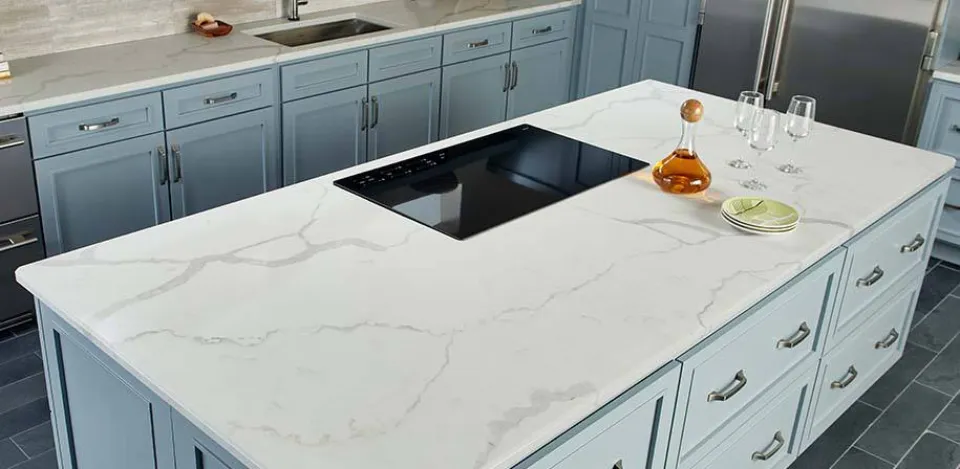
Conclusion: Quartzite Vs Quartz
You should now be able to see why quartz would win a contest between it and quartzite without a doubt.
Permit me to quickly review.
More customization is possible thanks to the quartz countertop manufacturing process. There will be more options for appearance as a result. With quartzite, you don’t have many options beyond the stone’s natural appearance.
Another aspect of quartz that shines is its low maintenance requirements. Quartz doesn’t need to be properly sealed, whereas quartzite needs to be resealed 1-2 times per year. Cleaning quartzite countertops is essential, even if the seal is adequate; otherwise, spills will pass through. In this regard, quartz is much more resilient.
Further, quartz offers greater resistance to cracking. As long as you use a cutting board, its softer nature shouldn’t be a problem.
Quartz countertops are a much better investment than quartzite countertops due to all of these factors taken together. Quartz will improve your enjoyment of your kitchen while also allowing you to use it as a selling point in the future.
Frequently Asked Questions
What is the Difference Between Quartz and Quartzite Countertops?
Natural, porous stone that has been precisely cut into rectangular pieces is used to make quartzite countertops. Quartz countertops are made of engineered stone that has been shaped to order. The percentage of loose quartz in high-quality examples is over 90%, with resins and other materials making up the remaining 7%. Quartz countertops will therefore provide greater resistance to stains, cracks, and chips, which is good news for you as the buyer.
How Much Do Quartzite Countertops Cost?
Kitchen countertops made of quartzite can cost anywhere from $60 to $100 per square foot. This was a reasonable price a long time ago. Today, engineered surfaces like quartz can be had for the same or less cost per square foot while providing even better performance and looks.
How Do You Remove Stains from Quartzite Countertops?
To remove stains from quartzite countertops, first try wiping the stain down with a mixture of water and mild dish detergent. If that doesn’t work, mix water with a few drops of ammonia and no greater than 12% strength hydrogen peroxide.
For persistent stains, use a poultice, which is a paste that you must generally place on the stained area, cover with plastic, and leave for a day or two.
What is the Durability of Quartzite Vs Quartz?
The durability of quartz is significantly higher. Quartzite is more prone to stains and chips. The more porous nature of the rock contributes greatly to the problem.
Check the following mop reviews before buying!
The Mr. Clean Spin Mop heads work best for dust mopping and absorb too much water for wet mopping. But wringing out the mop is extremely difficult.
When it comes to surface exposure, the Libman Tornado Twist Mop is a far better option than sponge mops. Even with vigorous scrubbing, you can clean with it effectively.
Mighty Thirsty Mop is a quick-absorbing mop made of polymer. Its thin mop head can fit underneath furniture and into other small spaces around the house.
If you have the Floor Police Motorized mop, you can quickly and easily spin away that dirt! The spin mop that does all the work for you is a cordless, lightweight product.
The cleaning efficacy and usability of the Bona Spray Mop are its greatest benefits. Use it to maintain the floors in between more thorough moppings.
With the Bissell PowerFresh steam mop, you can mop more effectively while saving money and combining convenience and power.
O Cedar Mop is incredibly shaky and spills way too easily. If you have to pick up the clean water tank, it will stop spinning and be inoperable.
The H20 X5 Mop won our comparison as the most adaptable mop. This mop effectively removed stains from the floor that had been there for several hours.
The Norwex Mop is available in two sizes (large and small) and three different mop pads. The system is easy to use if you follow the directions.

The Shark Steam Mop is a cheap steam mop that does a good job of sweeping and disinfecting floors. This Shark steam mop is a lightweight, simple-to-use steam cleaner.

